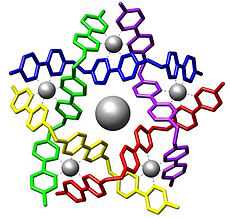Supramolecular assembly


A supramolecular assembly or "supermolecule" is a well defined complex of molecules held together by noncovalent bonds. While a supramolecular assembly can be simply composed of two molecules (e.g., a DNA double helix or an inclusion compound), it is more often used to denote larger complexes of molecules that form sphere-, rod-, or sheet-like species. The dimensions of supramolecular assemblies can range from nanometers to micrometers. Thus they allow access to nanoscale objects using a bottom-up approach in far fewer steps than a single molecule of similar dimensions.
The process by which a supramolecular assembly forms is called molecular self-assembly. Some try to distinguish self-assembly as the process by which individual molecules form the defined aggregate. Self-organization, then, is the process by which those aggregates create higher-order structures. This can become useful when talking about liquid crystals and block copolymers.
Applications
Supramolecular assemblies are being investigated as new materials in a variety of contexts. For instance, Samuel I. Stupp and coworkers at Northwestern University showed that a supramolecular assembly of peptide amphiphiles in the form of nanofibers could be used to promote the growth of neurons. A great advantage to this supramolecular approach is that the nanofibers will degrade back into the individual peptide molecules that can be broken down by the body.
Another example with implications at the biology/materials science interface is of self-assembling dendritic dipeptides, which form hollow cylindrical supramolecular assemblies in solution and in bulk. The cylindrical assemblies possess internal helical order and self-organize into columnar liquid crystalline lattices. When inserted into vesicular membranes, the porous cylindrical assemblies mediate transport of protons across the membrane.
Self-assembling dendrons have also been used to generate arrays of nanowires. Electron donor-acceptor complexes comprise the core of the cylindrical supramolecular assemblies, which further self-organize into two-dimensional columnar liquid crystaline lattices. Each cylindrical supramolecular assembly functions as an individual wire. High charge carrier mobilities for holes and electrons were obtained.
See also
| Part of a series of articles on |
| Molecular self-assembly |
|---|
|
|
- Molecular self-assembly
- Helicates
- Host-guest chemistry
- Supramolecular chemistry
- Crystal engineering
References
- ^ Selective Differentiation of Neural Progenitor Cells by High-Epitope Density Nanofibers Gabriel A. Silva, Catherine Czeisler, Krista L. Niece, Elia Beniash, Daniel A. Harrington, John A. Kessler, Samuel I. Stupp Science Volume 303, Issue 5662, Pages 1352-1355 2004 Abstract
- ^ "Self-assembly of Amphiphilic Dendritic Dipeptides into Helical Pores" Virgil Percec, Andrés E. Dulcey, Vekatachalapathy S. K. Balagarusamy, Yoshiko Miura, Jan Smidrkal, Mihai Peterca, Sami Nummelin, Ulrica Edlund, Steven D. Hudson, Paul A. Heiney, Hu Duan, Sergei N. Magonov & Sergei A. Vinogradov Nature 2004, 430(7001), 764-768 Abstract
- ^ "Self-organization of Supramolecular Helical Dendrimers into Complex Electronic Materials" V. Percec, M. Glodde, T. K. Bera, I. Shiyanovskaya, K. D. Singer, V. S. K. Balagarusamy, P. A. Heiney, I. Schnell, A. Rapp, H.-W. Spiess, S. D. Hudson & H. Duan Nature 2002, 419(6905), 384-387.
Further reading
- Topical review "Challenges and breakthroughs in recent research on self-assembly" Sci. Technol. Adv. Mater. 9 No 1(2008) 014109 (96 pages) free download
- Topical review "Metallo-supramolecular modules as a paradigm for materials science" Sci. Technol. Adv. Mater. 9 No 1(2008) 014103 (25 pages) free download
- Topical review "Chemistry and application of flexible porous coordination polymers" Sci. Technol. Adv. Mater. 9 No 1(2008) 014108 (12 pages) free download